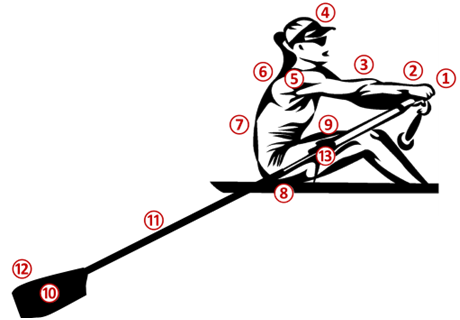|
|
Observe rower(s) |

The observing of the rowing motion is done using fourteen key observation points. Nine points run from the hands to the feet of a rower. In addition, there are five observation points that provide additional information:
- Hands/handle – important to see the stroke rhythm, release and catch.
- Wrists – is the position of the wrists correct?
- Arms – show how the blade is placed and through the bending when the arms are deployed.
- Head – shows if it is upright.
- Shoulders – show if they are low.
- Trunk – shows when trunk rotation is initiated.
- Spine – shows whether the spine properly fixed.
- Seat – shows sliding speed and direct catch.
- Legs – show slide speed and leg drive.
- Blade – shows the water handling.
- Oars (crew) – show the similarity through parallelism.
- Puddles (crew) – show the individual power contribution.
- oarlocks (boat) – show the oarlock pressure and balance.
- Stern (boat) – shows the quality of catch and leg drive.

To make good use of these observation points, it is important to use them in a structured way. Start at the stroke and end at the bow. Check for each rower in succession:
- the injury-prone points: wrists, shoulders and spine;
- the order of movement in the draw: legs, trunk and arms;
- the sequence of movement in the recovery: trunk + arms and legs;
- the water handling at finish and recovery: blade and hands;
- the water handling at catch: blade, hands and legs;
Then check the crew:
- first the similarity, rhythm and contrast of the crew: oars, hands, blades, seats and legs;
- then the balance of the crew: blades, oarlocks and hands;
- finally the fluency of the boat: stern.
 |
Knowing the rowing stroke |
 |
Choose misstake |
This article was translated automatically and is provided to you for free. You are most welcome to improve it!











